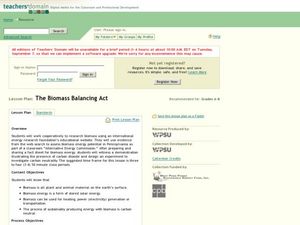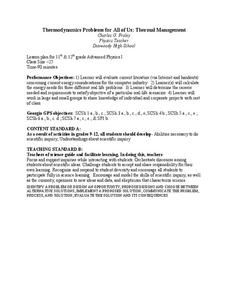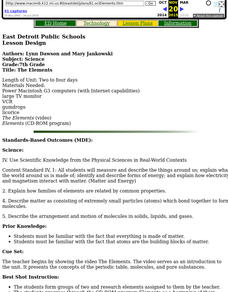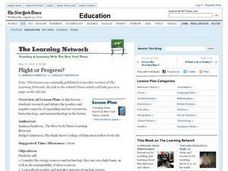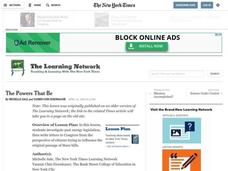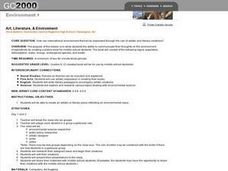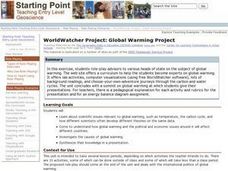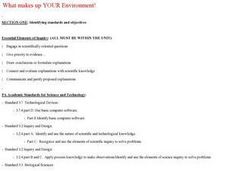Cornell University
Atomic Bonding
Explore the connection of surface area to bonding within atoms. Learners complete lab investigations to model changing surface area with different sizes and concentrations of atoms. A flour fireball demonstration follows the labs to...
Curated OER
The Biomass Balancing Act
Students work in groups to research biomass using the International Energy Agency's website. Students use evidence from the web search to assess biomass energy potential in Pennsylvania as part of a classroom "Alternative Energy...
Curated OER
Thermodynamics Problems for All of Us: Thermal Management
Young scholars evaluate current literature on the Internet and in handouts about the energy considerations for the computer industry and calculate energy needs for real life problems. Working in groups, they present the problem they...
Curated OER
Power Plans
In this lesson, young scholars consider what they already know about nuclear power and its uses and then examine an accident at a nuclear power plant. They then research and create reports on nuclear energy.
Curated OER
The Elements
Students watch video, The Elements, research information about elements using both the Internet and CD-ROM program, and create atoms out of gumdrops and licorice.
Curated OER
E-Cycling!
Eighth graders research how and why electronics are recycled. In this earth science lesson, 8th graders determine the types of materials electronic devices are made up of. They produce a creative ad to encourage people to recycle.
Curated OER
Bad Algae!
Students explore algal blooms. In this ecosystem and health lesson, students define and describe harmful algal blooms, then discuss ways in which the impact of these algal blooms could be reduced. Students work in groups to...
Curated OER
Plight or Progress?
Students read an online article to study the positive and negative aspects of nuclear energy, biotechnology, and nanotechnology. They conduct a debate on technology of the future.
Curated OER
Einstein's Big Idea
Students investigate the concept of the Einstein's Theory of Relativity while conducting research using the internet and following the outline of the objectives to guide the information search. The lesson plan includes background...
Curated OER
The Powers That Be
Students investigate past energy legislation, then write letters to Congress from the perspective of citizens trying to influence the original passage of these bills. Each small group does their research using a website imbedded in this...
Curated OER
Seismic Waves
Students identify the four types of seismic waves, their characteristics and effects. Then they predict the level of damage each wave might cause in a residential area and test their predictions against several computer animations. ...
Curated OER
Art, Literature, & Environment
Students communicate their thoughts on the environment by creating picture books for middle school students. Students include their thoughts on population, deforestation, water, energy, endangered species, and waste in their picture...
Curated OER
The Mighty Hudson Stretches its Mussels
Students brainstorm possible causes of zebra mussel migration and population expansion. They identify the key causes and effects of the disturbance of the Hudson River ecosystem and research causes and effects in the disturbances of...
Curated OER
Island of the Blue Dolphins Jigsaw
Fourth graders research three topics from the book, either Village Life, Sea Life, or San Nicholas Island. They research independently and meet in a jigsaw format to share what they learned. As group they create a poster for class...
Curated OER
All the President's Men and Women
Students research responsibilities, programs and government departments of leaders that make up the presidential cabinet, in the form of a Web Exploration, after reading "Dueling Power Centers" from The New York Times.
Curated OER
Wild About Wildfires
Students conduct a debate. In this wildfire and controlled burning lesson, students watch the video "Legacy of Fire" and discuss the topic of wildland fires and controlled burns. Half of the class researches the arguments for these...
Curated OER
Scooting Along!
Learners investigate how Newton's Third Law affects vehicle design. In this Newton's Third Law instructional activity, students use a web site to research Newton, his third law, and how to design a vehicle that uses a balloon for power....
Curated OER
Shark Food
Students create a linking chain to demonstrate the food chain. In this food chain lesson, students use the Internet to research sharks, including what they eat, and create a chain link with a picture of a shark. They continue...
Curated OER
WorldWatcher Project: Global Warming Project
Students conduct lab activities, computer visualizations, and other various forms of research in preparation for a role-play activity in which they assume the identities of advisors to various heads of state on the subject of global...
Curated OER
A Fallen Giant
Students investigate the economic concepts related to the fall of Enron in order to begin unraveling this complex scandal. They do research in small groups to identify such things as the Securities Exchange Commission.
Curated OER
The Many Uses of Trees
Young scholars list all the ways humans use trees and tree by products. In this lesson students watch a video, discuss the impact trees have on humans, and research common products made from trees. The young scholars use their findings...
Curated OER
Panther Trivia Pursuit
Sixth graders design trivia game about panthers. In this panther trivia game lesson plan, 6th graders use the Internet to research interesting information about panthers, write the facts on note cards, and create a game based on...
Curated OER
What makes up YOUR Environment!
Students create their own land or water environment. They make their environment livable for all the different animals they collect to put in it. Students research the types of animals that they can have in their environment, and how...
Curated OER
Ecosystems Connect
Students investigate ecosystems near their school and across the world. They examine both living (biotic) and non-living (abiotic) elements of each. They recognize ecosystems from various continents around the globe. The use of computers...

